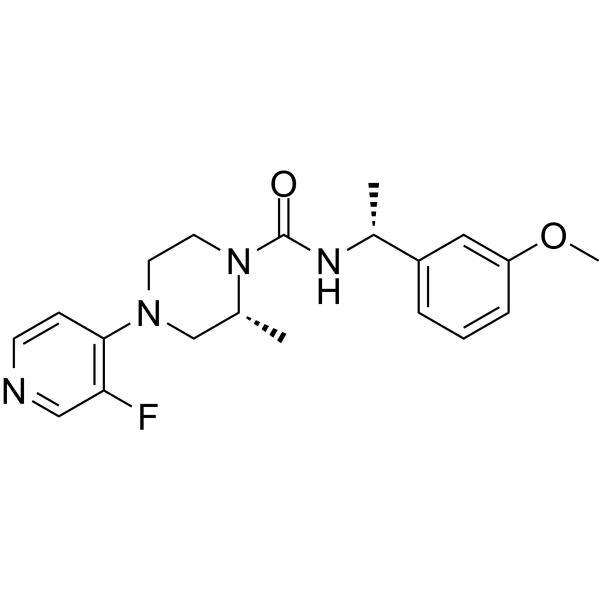Rho-Kinase-IN-2
Modify Date: 2025-08-29 06:35:05

Rho-Kinase-IN-2 structure
|
Common Name | Rho-Kinase-IN-2 | ||
|---|---|---|---|---|
| CAS Number | 2573071-18-6 | Molecular Weight | 372.44 | |
| Density | N/A | Boiling Point | N/A | |
| Molecular Formula | C20H25FN4O2 | Melting Point | N/A | |
| MSDS | N/A | Flash Point | N/A | |
Use of Rho-Kinase-IN-2Rho-Kinase-IN-2 (Compound 23) is an orally active, selective, and central nervous system (CNS)-penetrant Rho Kinase (ROCK) inhibitor (ROCK2 IC50=3 nM). Rho-Kinase-IN-2 can be used in Huntington’s research[1]. |
| Name | Rho-Kinase-IN-2 |
|---|
| Description | Rho-Kinase-IN-2 (Compound 23) is an orally active, selective, and central nervous system (CNS)-penetrant Rho Kinase (ROCK) inhibitor (ROCK2 IC50=3 nM). Rho-Kinase-IN-2 can be used in Huntington’s research[1]. |
|---|---|
| Related Catalog | |
| Target |
ROCK2:3 nM (IC50) |
| In Vitro | Rho-Kinase-IN-2 (0-10 mM, 1 hour) treatment shows an increase in AKT phosphorylation and a decrease in MYPT1 phosphorylation[1]. Western Blot Analysis[1] Cell Line: A7r5 and PANC1 cells Concentration: 0-10 mM Incubation Time: 1 hour Result: Showed concentration-dependent effects, leading to an increase in AKT phosphorylation (EC50=28 nM) and a decrease in MYPT1 phosphorylation (IC50=14 nM). |
| In Vivo | Rho-Kinase-IN-2 (Oral adiministration; 10 mg/kg; 6 times; 0.5, 1, 2, 4, 8, and 12 h) treatment shows dose- and time-dependent ROCK1 and ROCK2 target engagement[1]. Rho-Kinase-IN-2 (Oral adiministration; 10 or 20 mg/kg; QD or BID; 2 weeks) treatment shows excellent tolerability assessment[1]. Rho-Kinase-IN-2 (Oral adiministration; 1-20 mg/kg; once) treatment shows a direct dose- and time-dependent relationship between brain exposure and MYPT1 phosphorylation status[1]. Rho-Kinase-IN-2 (Oral adiministration; 10 or 20 mg/kg; once) treatment decreases in the mean arterial, systolic, diastolic blood pressure, and heart rate[1]. Rho-Kinase-IN-2 (Oral adiministration; 10 mg/kg; twice a day; 90 days) treatment leads to lower-than-expected brain concentrations[1]. Animal Model: Male C57BL/6 mice[1] Dosage: 10 mg/kg Administration: Oral adiministration; 10 mg/kg; 6 times; 0.5, 1, 2, 4, 8, and 12 h Result: Observed dose- and time-dependent ROCK1 and ROCK2 TE, with a free brain KiNativ ROCK1 and ROCK2 IC50=∼6 nM. Animal Model: 3−4 months old heterozygote Q175DN KI and wild-type littermate mice[1] Dosage: 10 or 20 mg/kg Administration: Oral adiministration; 10 or 20 mg/kg; once a day or twice a day; 2 weeks Result: Scored neurological index normally at all doses although a slight loss in bodyweight (∼2%) in the 20 mg/kg treatment group. Animal Model: Heterozygote HTT zQ175DN knock-in mice[1] Dosage: 1-20 mg/kg Administration: Oral adiministration; 1-20 mg/kg; once Result: Remained over MYPT1 IC50 for over 2 h of the free brain at 10 mg/kg, and observed the dose- and time-dependent inhibition of MYPT1 phosphorylation in the striatum following acute in vivo dosing. Animal Model: CD1 mice[1] Dosage: 10 and 20 mg/kg Administration: Oral adiministration; 10 or 20 mg/kg; once Result: Observed the decreases in the mean arterial (maximum change of 61.0 ± 8.5 mmHg from baseline), systolic (maximum change of 59.5 ± 8.4 mmHg from baseline), diastolic blood pressure (maximum change of 56.4 ± 9.0 mmHg from baseline), and heart rate (maximum change from predose of 107 bpm) when compared to the control group from ∼0.5 to 2 h post dose. Animal Model: Heterozygote Q175DN KI mouse model of HD[1] Dosage: 10 mg/kg Administration: Oral adiministration; 10 mg/kg; twice a day; 90 days Result: Led to lower-than-expected brain concentrations compared to single dosing. |
| References |
| Molecular Formula | C20H25FN4O2 |
|---|---|
| Molecular Weight | 372.44 |